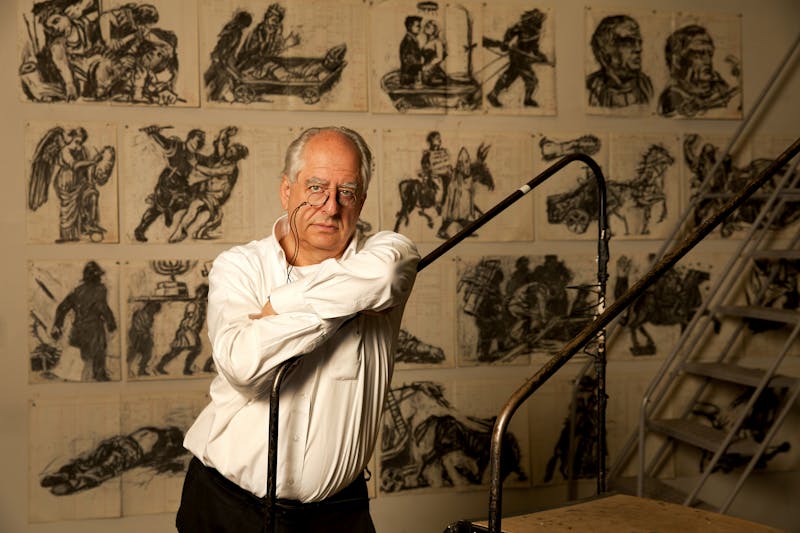It begins with sirens, a weird greasy glissando creeping up the register then back down again. The sound is so familiar, but with a shock one realizes that these sirens are not mechanical—they are being sung. Voices, somewhere between a scream and an aria. Dotted across the enormous stage at the Park Avenue Armory, performers in William Kentridge’s The Head and the Load are wailing in the dark.
Kentridge is a white South African artist known for a body of work—drawing, painting, animation, and performance—that engages with the colonial and postcolonial history of both his country and the wider continent. The new production’s name comes from a Ghanaian proverb: “The head and the load are the troubles of the neck.” It is a work of historical investigation and reclamation, focused on the African carriers and porters—two million of them—who lugged around the possessions of British, French, and German forces during World War One.
As with the best of Kentridge’s work, The Head and the Load is a kaleidoscopic affair. There are numerous collaborators: The music was composed by Philip Miller and Thuthuka Sibisi and played by the Brooklyn ensemble The Knights, while the long list of extraordinary performers include Ann Masina, Nhlanhla Mahlangu, and N’Faly Kouyaté. The production itself is a collage of many media, embodying our patchwork understanding of history itself.
We hear the famous letter from the Reverend John Chilembwe, who wrote a stinging open letter against the recruitment of Nyasa men into World War I, asking, “Will there be any good prospects for the natives after ... the war?” We hear snippets of military drills, Morse code, dogs barking, Frantz Fanon translated into siSwati. The words are both literary (e.g. Aimé Césaire) and historical, such as the lines taken from the fatal Berlin conference of 1884, in which European powers divided the continent between themselves. The music, too, is a mixture, both an homage to traditional African music and the European avant-garde European (Schoenberg, Paul Hindemith).
All these forms harmonize, in the sense that they produce something coherently beautiful. But they are also explicitly in conflict. A white actress puts on a helmet crowned with an eagle and snarls a German cabaret song, while the black performers who sing back at her are resisting harmonically. It’s a straightforward articulation of political conflict through music.

Like Kentridge’s Refuse the Hour production at the Brooklyn Academy of Music in 2015, the performances take place against a backdrop of dynamic projections. White explosions made with an eraser burst across a landscape drawn in charcoal. A dancer’s animated shadow follows him as he races across a battlefield, then falls when he does. Performers carry “drawings” that turn into moving shadow puppets.
The projections also contain specific historical references. We see a map of Madagascar, dated 1905. We see calculations about “wastage”—the percentage of carriers who might die on the road, for example—made on the white-owned “Kleinfontein Company Limited” letterhead. Those calculations are important, since Kentridge’s chief historical metaphor is the ambiguous truth offered by math. The two million porters and carriers existed in almost unthinkable numbers, so Kentridge’s performers break it down: three carriers per soldier. Nine for an officer. Twelve carriers for a machine gun. These statistics are significant, representing the lived experience of unsung heroes. They are also meaningless, mere data on a page.
The Head and the Load is a performance about the written record, which is both truth and nonsense: The names, dates, and figures of war and colonization are not the same as experience, but they show us, in stark figures, which people were named and which were merely counted. Kentridge’s approach conveys the illegibility of colonialism’s official record, while offering art as a way to make new sense of it.
Out of this tension—between the historical specificity of maps and ledgers on the one hand, and the clarion, yet ephemeral voice of a humanity on the other—arises a kind of a historiography. By ceding so much creative direction to his collaborators (and it cannot be emphasized enough how excellent these performers are), Kentridge has made a work defined by its inclusive approach to history, by its ethics.

This is a storyline that is particularly appealing to Western liberal audiences, but Kentridge’s own reputation back in South Africa is a little more fraught. His credibility derives from the political art he made in the ‘70s and ‘80s, when it was not safe for an “agitator” to work that way. And the high production values of his work are rare in South African art, because of a general lack of funding, so he sets a gold standard and has funded art enterprises like The Centre for the Less Good Idea.
But Kentridge’s continual reference to abstract traditions in European art, like Dadaism, and the remoteness of his practice from contemporary struggles in South Africa, make his work a little less urgent. Meanwhile, opera, which features so heavily in this performance, has a very specific cultural valence in South Africa: Many of the best opera singers there come from townships or poor rural villages, even though it is a form that still caters to the most elite audiences. Watching The Head and the Load, there is a sense that his collaborators bathe him in a kind of unearned, reflected glory.
Still, there’s no denying the fact that this production at the Park Avenue Armory is not only enormous in scale, but also capacious in its embrace of history. Maybe the European tradition of avant-garde composition serves us best when it’s used in this way: cut up and assailed by other voices; drowned out by its own history.